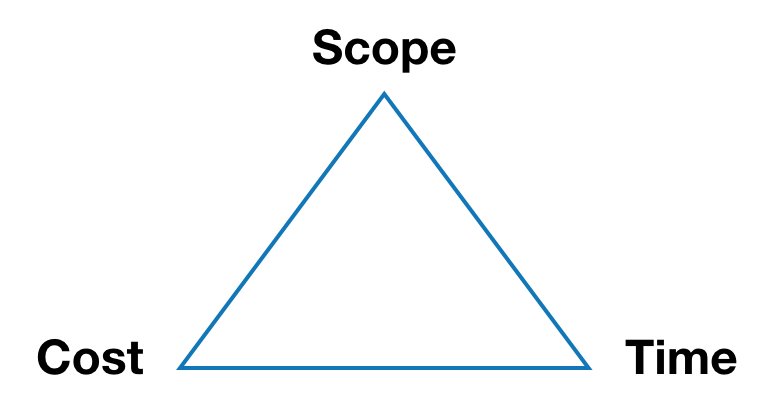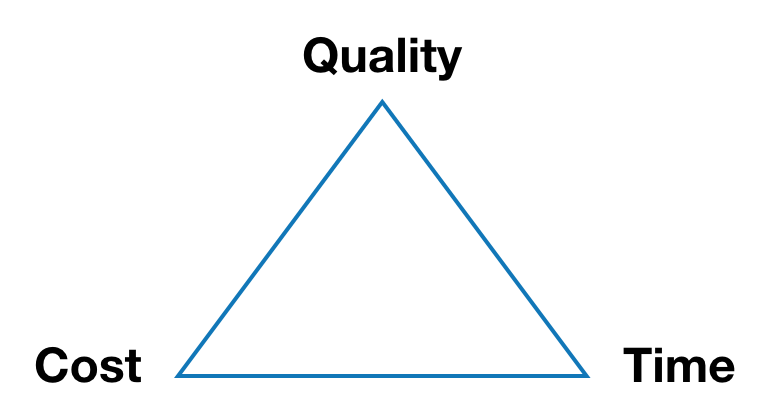The Triple Constraint in Project Management
(→Introducing the Triple Constraint) |
(→Introducing the Triple Constraint) |
||
| Line 10: | Line 10: | ||
The concept of the triplet constraint has various interpretations depending on time period and conviction and has been widely used since the 1950s. The Iron Triangle discussed by Atkinson back in 1999 had quality, time and cost as the three constraints <ref name="Atkinson" />. Even though the many different interpretations, Van Wyngaard et al. (2012) claims the general consensus seem to be that time, cost and project scope form the tree key variables in the Triple Constraint (Figure 1) <ref name="VanWyngaard" />. The discussion is however still ongoing and some of the newest research by Pollack et al. (2018) claims the triple constraint consists of time, cost, quality (Figure 2) <ref name="Pollack" />. [[File:TCQ.png|center|frame|Figure 2: The Triple Constraint model as presented by Atkinson (1999) and Pollack et al. (2018) <ref name="Atkinson"/> <ref name="Pollack"/>]] | The concept of the triplet constraint has various interpretations depending on time period and conviction and has been widely used since the 1950s. The Iron Triangle discussed by Atkinson back in 1999 had quality, time and cost as the three constraints <ref name="Atkinson" />. Even though the many different interpretations, Van Wyngaard et al. (2012) claims the general consensus seem to be that time, cost and project scope form the tree key variables in the Triple Constraint (Figure 1) <ref name="VanWyngaard" />. The discussion is however still ongoing and some of the newest research by Pollack et al. (2018) claims the triple constraint consists of time, cost, quality (Figure 2) <ref name="Pollack" />. [[File:TCQ.png|center|frame|Figure 2: The Triple Constraint model as presented by Atkinson (1999) and Pollack et al. (2018) <ref name="Atkinson"/> <ref name="Pollack"/>]] | ||
| + | |||
| + | Whether taking basis in the Triplet Constraint model with time, cost and scope or time, cost and quality the time characterises the duration of the project and the scheduling and the cost addresses the budget and resources (Figure 1 and Figure 2). The scope denote the tasks required to fulfill the project's goals and this could also be the quality constrain which denote the quality criteria set for the project. If The triple constraint model formed by these three constraints can be used to evaluate projects. The model states that the success of a project is impacted by those three constraints. During the project's life cycle it is the project managers job to balance between the time, cost and scope/quality to obtain trade-offs within a reasonable limit to obtain a successful project. This model implies that the project quality or successfully completion is affected by the trade-offs performed and it is the project managers job to know how the three constraints interrelate. It is however not possible to use the model to actually determine success, which is why the model is often used wrongly <ref name="Westland"/>. Because of the mutual dependency between time, cost and scope/quality, a change in one of the constraints will affect the others making this model a useful tool in order to explain the effect or consequence of changes to project stakeholders. | ||
==References== | ==References== | ||
<references /> | <references /> | ||
Revision as of 14:24, 21 February 2019
Abstract
When managing a project several aspects constraints the project. These constraints are interdependent and the three key constraints form what has traditionally been known as the The Triple Constraint or The Iron Triangle. Some claim time, scope and cost (TCS) to be the key constraints others claim it is time, cost and quality (TCQ) [1] [2]. It is either way the project managers job to balance between the constraints to obtain trade-offs within a reasonable limit during the project's life cycle to obtain a successful project. The model implies that the project's successful completion is affected by the trade-offs performed and it is the project managers job to know how the constraints interrelate. The model however does not determine success [3]. The model has been widely used since the 1950s and the application and limitations have been discussed extensively [4]. Atkinson is one of the critics who claims the model is insufficient for determine the project success, because success rely on several additional factors and not only the three constraints [4]. Others are more positive, but in general it seem that many would like to modify the model to improve the interpretation [1]. Predominantly there seems to be a disagreement about whether scope or cost is the third constraint in the triangle. The aim of this paper is to explain the concept of the triplet constrain and it's application and limitations in project management and to reflect on the different perspectives.
Contents |
Introducing the Triple Constraint
When managing a project there are several types of constraints e.g Cost, scope, schedule, resources and quality [5]. In fact the PMBOK guide has divided the chapters about project management into exactly these constraints and how to manage them in a project i.e project scope management, project schedule management and so forth [6]. These constraints are often interdependent of each other which is why it is important to balance the constraints against each other. According to ISO 12500 this means that a change in one constraint might affect the others [5]. In project management the three key constraints are often considered to be either time, cost and scope or time, cost and quality. These tree constraints either (TCS or TCQ) form what is known as The Triple Constraint or The Iron Triangle (Figure 1 and 2).
Whether taking basis in the Triplet Constraint model with time, cost and scope or time, cost and quality the time characterises the duration of the project and the scheduling and the cost addresses the budget and resources (Figure 1 and Figure 2). The scope denote the tasks required to fulfill the project's goals and this could also be the quality constrain which denote the quality criteria set for the project. If The triple constraint model formed by these three constraints can be used to evaluate projects. The model states that the success of a project is impacted by those three constraints. During the project's life cycle it is the project managers job to balance between the time, cost and scope/quality to obtain trade-offs within a reasonable limit to obtain a successful project. This model implies that the project quality or successfully completion is affected by the trade-offs performed and it is the project managers job to know how the three constraints interrelate. It is however not possible to use the model to actually determine success, which is why the model is often used wrongly [3]. Because of the mutual dependency between time, cost and scope/quality, a change in one of the constraints will affect the others making this model a useful tool in order to explain the effect or consequence of changes to project stakeholders.
References
- ↑ 1.0 1.1 1.2 1.3 Van Wyngaard, C.J., Pretorius, J. H. C., Pretorius, L. Theory of the triple constraint – a conceptual review. IEEE International Conference on Industrial Engineering and Engineering Management, 13:1991–1997, (2012).
- ↑ 2.0 2.1 2.2 Pollack, J., Helm, J., and Adler, D. What is the iron triangle, and how has it changed? International Journal of Managing Projects in Business, 11(2):527–547, 2018, (2018).
- ↑ 3.0 3.1 Westland, J. The triple Constraint in Project Management: Time, Scope Cost. [Online] https://www.projectmanager.com/blog/triple-constraint-project-management-time-scope-cost, Accessed: 02-16-2019, (2018)
- ↑ 4.0 4.1 4.2 4.3 Atkinson, R. Project Management: Cost, Time and Quality, Two Best Guesses and a Phenomenon, it's Time to Accept Other Success Criteria. International Journal of ProjectManagement, 17(6):337–342,(1999).
- ↑ 5.0 5.1 Danish Standards DS/ISO 21500:2013 - Guidance on Project Management. Danish Standards, 2. edition, (2013)
- ↑ A Guide to Project Management Body of Knowledge Project Management Institute, 6.edition,(2017)
